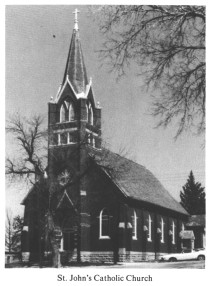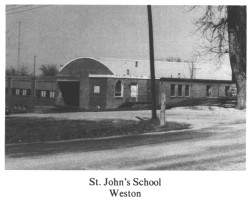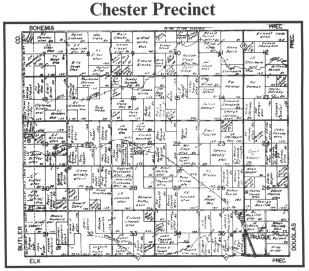CZECH PRESBYTERIAN
CENTENNIAL
The Czech United Presbyterian Church near Wahoo, Nebraska celebrated its centennial on August 15, 1982. The day's events included morning worship with communion at 10 A.M., a catered meal at noon, a time for remembrance and greetings at 2 P.M., and lunch at 4:30, followed by vespers in song at 5:30.
Formerly known as the Bohemian Moravian Evangelical Reformed Society, the church was organized on January 8, 1882 with 12 families, immigrants from Moravia and Bohemia.
The original worship services were held in homes and a public school building 1½ miles north of the present church. Annual worship services were conducted by the Rev. F. Kun of Ely, Iowa.
The first church edifice was dedicated Nov.11, 1888 while the present brick building was dedicated Mar. 17, 1929. The Czech language was used exclusively in the worship services until 1948. It was not replaced by English entirely until 1953 when Rev. Donald Proett became pastor of the church.
In 1966, a new manse was erected and is now occupied by the pastor, Rev. L. Paul Fiedler. Friends from across the presbytery were invited to share in the celebration.
ST. JOHN'S CATHOLIC CHURCH,
WESTON
The first Mass for Czechs in the Weston vicinity was celebrated by Rev. Jordan Stutz in Mr. Faimon's harness shop or his home. Sometimes Masses were held in a Weston school.
When the church was built in Plasi, the Weston Catholics decided that they, too, wanted their own church. In July, 1885 ground was purchased although there were only eighteen parish families. After much hard work and overcoming many obstacles, the church was completed the same year. The building measured 24 by 30 feet. It was named in honor of St. John Nepomuc.
On December 8,1885 Mass was said for the first time in the new church. Father William Choka of Omaha was the celebrant. Frank Hakel and Anna Novak was the first couple to be married in the small wooden frame church. Emanuel Kopecky was the first known baptism and Marie Bartek, 20, was the first funeral recorded.
Under the leadership of Rev. Alois Klein, who attended the Weston needs from Wahoo, the church building was enlarged, more lots were added to the site, membership was increased, sodalities were formed, and the organization of the parish was completed.
Rev. Klein was succeeded by Rev. Bor, who came from Wahoo every other Sunday until February, 1915 when he was made resident priest. On October 10, 1904 Father Bor began taking subscriptions for a new church to relieve the crowded conditions caused by the fast growing congregation. In three days he accumulated $10,000. The new brick building measured 101 by 42 feet. The architect was Craddock of Lincoln and the contract was awarded to Jacob Ort for $12,750. The edifice was erected on the same site as the first church. Besides monetary gifts, many parishoners donated hundreds of hours of labor. They had the joy and satisfaction of witnessing the dedication of a new building on June 25, 1906 by Bishop Bonacum.
In 1915 the parishoners constructed a frame buildingjust east of the church as a rectory for their first resident pastor. Father Bor resigned in 1925. His successors were Fathers Francis Kopecky, Michael Pazourek, Victor Mlejnek, Otto Ekhaml, Paul York, and Peter Gadient.
In 1947 the entire church was renovated. In 1953 an Angelus Bell System was installed and a new organ was purchased in memory of all who served in the Armed Forces.
In the early 1950's the rectory was remodeled. At one time there was a balcony above the porch, but it was removed and pillars were put in. The entire inside was redecorated by Rev. Ekhaml, personally.
 |
| St. John's Catholic Church |
The construction of a parochial school was begun in July, 1954. The cornerstone for the new building which included a convent and auditorium was blessed by Bishop Kucera on September 26, 1954. The building was completed in 1956.
In 1976 under Father Paul York's direction the church and school were remodeled and repaired. Approximately one hundred parishioners volunteered their services.
The church stands today as a memorial to the Moravian immigrants as well as a place of worship for the present congregation. by Marie Rezac and Charlotte Sousek
ST. JOHN'S SCHOOL -- WESTON
The idea of building a Catholic School at St. John's in Weston goes back to the early Thirties when plans and designs were made which then would have cost about $35,000. Depression forced these ideas to be shelved until after World War II.
 |
St. John's School
Weston |
By January 1954, after Rev. Otto Ekhaml, the parish priest, had completed extensive repairs to the church and rectory, he decided it was time to start on the long-awaited school. At the first parish meeting of that year he announced that fund raising would commence immediately. Construction would begin in the summer. Ground was broken in July with little more than great vision and faith. The amount needed for the school was $126,000, while contributions at the time amounted to $1,685.
Assisting Father Ekhaml at the ground breaking were Rev. Walter Potacki of St. Mary's and Rev. George Livanec of Morse Bluff. Architect was Harold Potter of Kansas City, while the builder was C. W. Harre of Lincoln.
Six weeks later the cornerstone was laid in formal ceremonies attended by Bishop Kucera. The day long festivities began with a solemn High Mass.
Procession to the cornerstone took place through a double row of Knights of Columbus members from Weston. Beef and chicken dinners were served by the Ladies Guild and a bazaar was held on Weston's Main Street. In the evening there was dancing provided by the KLMS Polka Band.
Construction continued all winter, with most of the brick work done through the use of temporary shelters and portable heaters. Masons were John Pitman, James Wiatt, and Nick White Horse.
One of the unique aspects of building the school was the amount of direct parish involvement. A large number of parishioners gave freely of their time and sometimes their machinery, tools and equipment. A March, 1955, newspaper item stated that it was estimated about four thousand hours of labor was given by fifty men and the exterior wasn't even completed at the time.
The original building committee for the project consisted of John J. Chapek, Francis P. O'Connor, Edward V. Meduna, and John J. Machacek. Later Paul Pleskac and John J. Svoboda were added to replace two members who had moved from the parish.
The school was formally dedicated in the spring of 1955, with hopes and plans to open it for the 1955-56 school term. Even though the school was not yet completed the ceremony took place that spring so it might coincide with the fiftieth anniversary of the construction of St. John's Church.
Bad weather caused a delay in the building schedule along with the construction of the gym roof. There was a major problem in assembling the pre-cut factory pieces, resulting in lost time, headaches, and grief.
Work on the interior proceeded through 1955 and the first half of 1956. By September school was ready to open. The first teaching staff consisted of Sister Bernarda, Sister Xavier, Sister Germaine, and Sister Grace.
The years of waiting, hard work, and sacrifice finally paid off on Monday, September 3, 1956 when fifty-six eager students walked through the school doors. The peak enrollment was in 1967-68 with 137 students. The first graduating class was Jeanne (Lukas) Allen, Joanne (Fiedler) Cherovsky, and Julie (Pleskac) Falleck. by Marie Rezac
ST. JOHN'S QUILTING CLUB
The St. John's Quilting Club of Weston was organized in the fall of 1976 at St. John's Parish Council of Catholic Women's meeting. The ladies began working on their first quilt on Nov. 9, 1976. In the beginning there were from seven to eight ladies. Later some dropped out and others came in.
The ladies quilt mostly for other people. Some people want their quilts tied and not quilted. Once in a while, the ladies will make a quilt for somebody from scratch, that is from beginning to end.
Every year there is also a quilt made which is raffled off at St. John's Annual Bazaar on the third Sunday in September. The ladies sell chances on the quilt.
For several years the quilting was done in an upstairs bedroom in St. John's Rectory. Since 1982, the ladies quilt in the basement under St. John's Convent. They quilt twice a week on Tuesday and Thursday afternoons from one to five. They usually take a coffee break around 2:30.
Two regular quilting members passed away after a long illness. One died in 1978 and one in 1979. At present there are seven members.
All the money the ladies earn for quilting goes to St. John's Parish to help with church expenses.
In March, 1981, the Wahoo Newspaper came to the rectory quilting room and interviewed the group. A picture appeared in the newspaper on Mar.12, 1981.
Many, many quilts have been quilted by the group in years since its organization. Submitted by Emma Rezac
page 62
DISTRICT #44
The first school in Chapman Precinct was organized in 1869. The first schoolhouse was completed in 1870 and was located in the middle of the section.
On March 23, 1876, the school board bought a half acre of land for one dollar from H. N. Roger for a new school site. In 1884 the school was moved to this site, located across the road and down the hill from the present school. In 1924 after many meetings it was decided to move the school up the hill, the reason given that the children didn't have enough room to play. The school was moved to where the basement was dug and the school was sitting on blocks over it, when a storm came up during the night and the school fell into the basement. Gus Barry, a school board member said, "That's the best thing that could have happened to that old building." So the present school was built.
In 1967 most of Dist. #71 joined this Dist. In 1973, part of Dist. #32 joined. In 1976 due to such a large enrollment, another room was added and the basement was enlarged at the same time. The present school board consists of: Tom Konecky Sr. -- Pres., Ben Pokorny -- Treas., Don Proett -- Sec.
UNITED STATES POST OFFICE
After crossing over the Union Pacific Railroad tracks the present United States Post Office, bearing the name of Weston, Nebr. 68070, officially a third class post office, is on the corner where the former Weston Bank and the James P. Svobeda & Son Mortuary were first located.
The first post office, bearing the name of Troy, was southeast of the present town of Weston, before Weston became a town. After Weston was platted in 1877 and the railroad came through, a building was moved in from Troy for a post office, and renamed Weston. The right side is the original and the left addition was built later. The post office, under the new title had reappointed William E. Hill, the first postmaster. Other postmasters were: Henry B. Hadsell and probably, Levi R. Olmstead at one time.
After many years in the old building, the post office was moved into the former Janak-Virgl Merchandise Store. Irma Davis, Charles A. Kadavy, Joe Kacirek and Anton Fisher were the postmasters. These two buildings were destroyed by fire in 1975, but in 1968, the post office had moved to its present location, long before the fire. Postmasters were: Joe Kacirek, Anton Fisher, Deryl Morton and at present, Ludvik Walla.
Since 1966, Richard W. Pascal, a World War II veteran, is the Rural Route Mail Carrier. Other Rural Route Mail Carriers were: Neil E. Samek, Frank Molak, Harry Lillibridge and Frank "Butch" Pavlik. John Wonka Jr. was a substitute Rural Route Mail Carrier for many years, starting in 1919. Ron Walla is the present substitute Rural Route Mail Carrier.
WESTON AMERICAN LEGION
POST 308 AND AUXILIARY UNIT
308
In 1947 Frank E. Woita, a veteran of World War I, organized the Post 308. It received its Charter in October of 1947 with 36 members. Meetings were held above what is now the Ponderosa bar, until the purchase ofthe drug store which was remodeled and newly painted for their meetings.
Activities of the post are holding joint Memorial Day services with the Auxiliary, sponsoring Boys' State and County government Day, co-sponsoring annual benefit drives, and Fourth of July Celebrations.
The Auxiliary was organized in 1947 by Mrs. Frank E. Woita. In January, 1948 its goal was reached and officers were elected. It received its charter in 1948. Its activities include Poppy Day, rehabilitation work, honoring Gold Star Mothers, sponsoring Girls' Staters, co-sponsoring annual benefit auctions, and preparing food for 4 Legion Stags. Submitted by Charlotte A. Sousek
STAR-LITE BALLROOM
The grand opening of the Star-Lite Ballroom was held on May 30, 1964. The co-owners and managers were Joe and Marie Cherovsky and Adrian and Betty Rezac.
Located three and one-half miles west of Wahoo on Highway 92, the spacious 100 by 150-foot building had a dance floor 50 by 100 feet. The seating capacity was 950.
A variety of music was enjoyed by all. Some of the big name bands who played at Star-Lite were Guy Lombardo, Jan Garber, and Glenn Miller, as well as many Nebraska polka bands. The most popular rock band was the "Rumbles." Guy Lombardo attracted the largest crowd with 1030 paid admissions. Wedding dances were very popular, and these helped various organizations raise money. Besides dances, Star-Lite also hosted organizational meetings and
dinners.
In August of 1970, a big windstorm caused extensive damage to the building. The owners decided to put it up for sale. Robert Schamp and his wife were the next owners. Later, Star-Lite was purchased by the Rudy Penkes, Jerry Bates, and Phil Bates. Currently, the ballroom is being operated by Gaylen Maly and Alan Hanke of Wahoo. by Adrian Rezac
 |
CHESTER PRECINCT |
 |
| (image links to larger map) |
CHESTER PRECINCT
Chester Precinct is located in the northwest part of Saunders County. It was first formed about the year 1871. There is very little history on record about the early days of the precinct. Most of the work of maintaining the roads was done by the farmers living in the area.
In 1948, three members of this precinct were elected to the precinct Board. These first board members were A. J. Hoffman, Carl B. Prai, and George J. Pacl. It was their duty to maintain the roads. The board later bought a road maintainer and hired an operator. There are about 45 miles of roads to be maintained in the precinct including the old railroad right of way.
The present board members are John Petrzelka, Frank Sousek, and Emil Ostry. Leonard Odvody is the operator of the road maintainer. In 1973, the precinct bought the old county shed where they now store the machine and supplies, and also hold their meetings.
The town of Prague is located in the southeast part of the precinct. There were two schools in the precinct at one time, District 73 and District 80. In the early days both schools had a large enrollment of pupils but as the population of the precinct decreased so did the schools. Finally, they were forced to close. Most of the farmers joined District 104 in Prague.
The village of Rescue was also located in Chester Precinct along the C.B. & Q. Railroad which went through this precinct. Rescue was a busy little community in the early days where farmers came to do their trading. It had an elevator, a garage, a grocery store, and a dance hall. In the late 1920's, a fire destroyed the elevator. After the railroad abandoned its tracks the town died out just as did many of the other small towns in the county.
The first birth in the precinct was a son to C. V. Bogardus, Feb. 1, 1872. First persons joined in marriage were Adam Wikel to Miss Martha Crisp, and the first death was a child of B. U. Traverse, who was buried on the farm of W. W. Holl. In the early part of 1872, a school was organized at Willow Creek, and a sod school house was erected. On May 5, Rev. Mr. Gregory preached the first sermon and organized a class of the Methodist Episcopal Church.
A great prairie fire swept over the precinct in Oct. 1871, and again in Oct. 1872, burning hay, stables, stock and much farm machinery. In April 1873, from the 12th to 15th, they experienced a terrible snow storm, with severe cold, freezing stock and some settlers froze to death. Aug. 4, 1873, grasshoppers made their first incursion, and July 23, 1874, was the beginning of their memorable festation.
In the year 1870, B. U. Traverse settled in Chester Precinct. During this year, Johnathan Crisp, David Wilson and Clayton Troth located here.
In the vicinity of Iowa Ridge, J. J. Miller and James Graham were the first settlers (1871), followed soon after by M. M. Runyon, Charles Riggs, H. L. Slowitts, who settled at this point early in the spring of 1872. Written by Emil Ostry
page 63
| 
